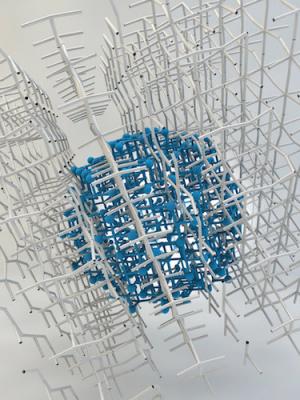Perovskite LED - Page 15
Perovskite-based phosphor-based white light converter
A team of researchers from the King Abdullah University of Science and Technology (KAUST) of the Kingdom of Saudi Arabia has reported a perovskite-based phosphor-based white light converter with a modulation bandwidth around 40 times higher than common LED phosphors. This result could put an end to today's VLC bottleneck when using white LEDs.

By mixing solution-processed CsPbBr3 perovskite nanocrystals (NCs) with a conventional red phosphor, they obtained what they describe as a perovskite-based phosphor white light converter with a modulation bandwidth of 491MHz, which could support high data rate up to 2 Gbit/s, much faster than Wi-Fi. In addition to exhibiting a shorter excited lifetime, the red phosphor and perovskite composite material yields a white light with a high colour rendering index of 89 and a correlated colour temperature of 3236 K, which makes the white LED suitable for comfort lighting applications.
Perovskite-based colloidal solutions make for efficient LEDs
Researchers at Nanyang Technological University in Singapore have fabricated high-performance green light-emitting diodes based on colloidal organometal perovskite nanoparticles. The devices have a maximum luminous efficiency of 11.49 cd/A, a power efficiency of 7.84 lm/W and an external quantum efficiency of 3.8%. This value is said to be about 3.5 times higher than that of the best colloidal perovskite quantum-dot-based LEDs previously made.

The team developed a simple way to make a series of colloidal (CH3NH3)PbX3 nanoparticles with an amorphous structure that can be tuned to emit light in the ultraviolet to near-infrared range. They studied the photoluminescence properties of the nanoparticles and found that the PLQE of the perovskite NP film is much higher than that of the bulk film. They then made the highly efficient green LED.
Perovskites assist in breaking bandwidth record for data communication
Researchers from the King Abdullah University of Science and Technology (KAUST) have designed a system that uses an innovative color converter based on luminescent materials known as phosphors, which are commonly used in LED lights, and combines them with nanocrystals of perovskite. This system has achieved record bandwidth, providing a data transmission rate of 2Gbit per second.

The major achievements in this work are breaking the record for data communication using visible light and, even more impressively, producing white light with a very high color-rendering index of 89, by designing a special color converter based on hybrid perovskite nanocrystals. The work demonstrates white light as both a lighting source and a system for ultra-high-speed data communications.
Perovskite matrix improves quantum-dot LEDs
Researchers at the University of Toronto in Canada and ShangaiTech University in China have succeeded in using colloidal quantum dots in a high-mobility perovskite matrix to make a near-infrared (NIR) light-emitting diode (LED) with a record electroluminescence power conversion efficiency of nearly 5% for this type of device. The NIR LED could find use in applications such as night vision devices, biomedical imaging, optical communications and computing.

The researchers say that they may have found a way to overcome the known problem of low power conversion efficiencies (PCEs) of CQD-based LEDs, by embedding CQDs in a high-mobility mixed-halide perovskite matrix. The new composite allows for radiative recombination in the quantum dots by preventing charge carriers from becoming trapped in defects as they travel through the material, and this without increasing the turn-on voltage in a device. By carefully engineering the composition of the mixed halide matrix, the researchers made bright NIR CQD LEDs with electroluminescence PCEs of 4.9%. This value is said to be more than twice that of previously reported values for devices made from these materials, which means that with same amount of electricity it is possible to get twice as much NIR light power out.
Perovskites can work together with QDs to improve LED and solar technologies
Researchers from the Universitat Jaume I and the Universitat de València have studied the interaction of two materials, halide perovskite and quantum dots, revealing significant potential for the development of advanced LEDs and more efficient solar cells.
The researchers quantified the "exciplex state" resulting from the coupling of halide perovskites and colloidal quantum dots. Both known separately for their optoelectronic properties, but when combined, these materials yield longer wavelengths than can be achieved by either material alone, plus easy tuning properties that together have the potential to introduce important changes in LED and solar technologies.
Will perovskite LEDs someday replace LEDs and OLEDs?
Researchers at Pohang University in Korea are reportedly the first to develop a perovskite light emitting diode (PeLED) that could replace organic LED (OLED) and quantum dot LED (QDLED).
Organic/inorganic hybrid perovskite have much higher color-purity at a lower cost compared to organic emitters and inorganic QD emitters. However, LEDs based on perovskite had previously shown a limited luminous efficiency, mainly due to significant exciton (a complex of an electron and hole that can allow light emission when it is radiatively recombined) dissociation in perovskite layers.
Perovskites may enable cheaper, more efficient LEDs
Florida State researchers have developed a cheaper, more efficient LED, or light-emitting diode, using perovskites.
The researchers spent months using synthetic chemistry to fine-tune the materials in the lab, creating a perovskite material capable of emitting a staggering 10,000 candelas per square meter when powered by 12 volts. The scientists say that such exceptional brightness owes, to a large extent, to the inherent high luminescent efficiency of this surface-treated, highly crystalline nanomaterial.
Pagination
- Previous page
- Page 15



